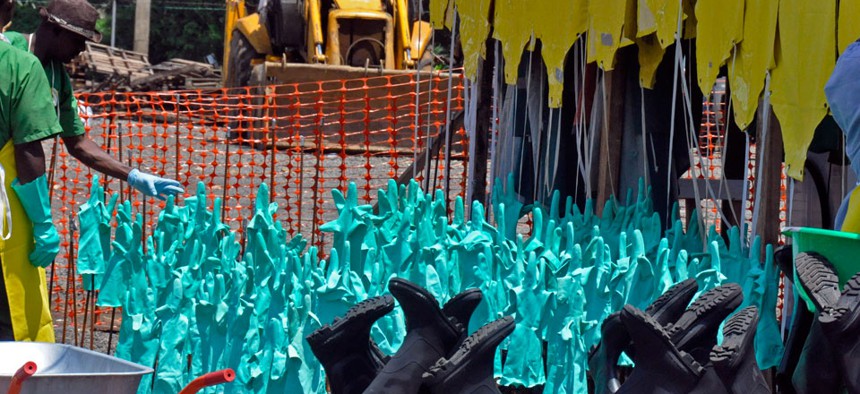Why a Simple Rubber Glove Could be Key to Fighting Ebola

Gloves and rubber boots forming part of the Ebola prevention gear for health workers at a clinic are set outside for the sun to dry them after being washed in Monrovia, Liberia. Abbas Dulleh/AP
Basic protective gear was revolutionary for 19th-century medicine, and health workers trying to stop Ebola are recognizing its importance all over again.
The first healthcare workers to use rubber gloves didn't don them for hygienic reasons, but for dermatological ones. Caroline Hampton, a niece of the Confederate general and future South Carolina governor Wade Hampton,graduated from nursing school in 1888 and moved to Baltimore in 1889 to work at Johns Hopkins Hospital under the surgeon William Halsted.
Hampton's delicate hands were soon covered in rashes from mercuric chloride and carbolic acid, the harsh disinfectants used at the time, as Robert Lathanexplained in a 2010 journal article.
Halsted said he "gave the matter my consideration, and one day in New York requested the Goodyear Rubber Company to make as an experiment two pair of thin rubber gloves with gauntlets," as Sherwin Nuland later recounted inDoctors: The Biography of Medicine. "On trial these proved to be so satisfactory that additional gloves were ordered."
Before long, all of Halsted's assistants were wearing the gloves, though Halsted himself resisted. That is, until another doctor, Joseph Bloodgood, came to Hopkins in 1892 to practice surgical pathology.
Bloodgood tried out the gloves on a lark. (“Why shouldn't the surgeon use them as well as the nurse?”) To Bloodgood's surprise, wearing them during hernia surgeries led to a dramatic drop-off in the infection rate. To which Halsted responded, fittingly:
“Why was I so blind not to have perceived the necessity for wearing them all the time?”
* * *
Today, every doctor understands the value of protective gear. The importance of rubber gloves is being felt even more intensely in their absence.
Though the CDC confirmed the first American Ebola case yesterday, the epidemic has been raging in West Africa for months. There, the disease hasalready claimed 3,000 lives, and more than 6,500 people have been infected. The number of cases is almost doubling every three weeks, a CDC spokesperson told reporters on a recent call.
Map of Ebola Outbreaks by Fatality Percentage
This outbreak has killed about 200 healthcare workers, as well, in part because of a lack of basic supplies and infrastructure, like hospital beds, bleach, and yes, gloves.
Ebola doesn't spread easily through the air, but it is highly transmissible through bodily fluids. The bodies of Ebola victims in particular can be like viral bombs, infecting almost everyone who comes into contact.
A recent study found that prior to the outbreak, only 63 percent of Liberia's hospitals had sterile gloves for doctors and nurses, and only 70 percent of Sierra Leone's did. In August, the Wall Street Journal reported that healthcare workers in Liberia were treating Ebola patients with bare hands because they lacked gloves. A doctor named Samuel Brisbane died there last summer, most likely after contracting the disease while administering cardiopulmonary resuscitation to an Ebola patient without protection. Just yesterday, the New York Times' Adam Nossiter described a Sierra Leone hospital where "nurses, some not wearing gloves and others in street clothes, clustered by the door as pools of the patients’ bodily fluids spread to the threshold."
Tony Morain, a spokesperson for Direct Relief International, told me that last week the group received a call from a hospital in Liberia. A doctor there said he had to stand and watch as a 2-year-old patient died—not from Ebola, but from an unrelated infection—because the hospital didn’t have any more gloves. Before the outbreak, the doctor said, they would have treated her, but now they can't risk touching a patient who might be carrying the virus.
"There are many basic needs given the scope of the epidemic," says Sue Desmond-Hellmann, CEO of the Gates Foundation, which last month committed $50 million to support relief efforts in the Ebola-stricken countries. Though some of the funds are going to developing vaccines and treatments, Desmond-Hellmann said many workers on the front lines still lack basic necessities. The needs "are not mysterious. It's just urgent and challenging to get all these logistics met."
Malaysia, the world's leading manufacturer of rubber gloves, sent 20 million pairs last month to the five affected countries. Direct Relief said that between Malaysia's gloves and the organization's own donation of 2.8 million pairs, there will be enough gloves to last for 130 to 260 more days. But that doesn't account for "correct glove sizes, breakage, distribution considerations, or exponential growth of the disease. Nor does it include burial teams, disinfection teams, ambulance transport teams, and investigation teams. It also doesn’t consider the preexisting need."
The U.S. government is also planning to distribute hundreds of thousands of protective kits for Liberians to use at home.
"It's a bucket that contains a sprayer, which is used for disinfectants; rolls of bags for capturing infected garments or items," USAID's Nancy Lindborg told NPR. There are also gowns, masks, soap, chlorine, and—you guessed it—gloves.
The kits are a stopgap measure until the U.S. military can finish building 17 new Ebola treatment centers across the affected region. No one expects people to be able to adequately care for their sick family members at home. But as 19th-century doctors would learn, a minimum level of protection is often much better than nothing.
NEXT STORY: NOAA taps NASA satellite manager for NESDIS





